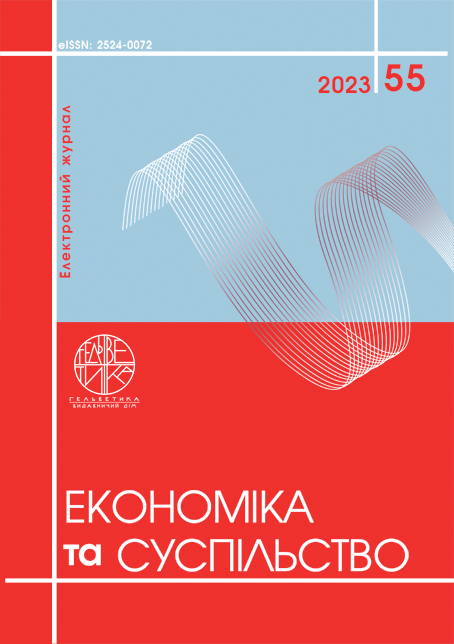FEATURES OF RECOGNITION AND ACCOUNTING FOR LOW-VALUE ASSETS
Abstract
The article is devoted to the issues of accounting for low-value assets, particularly their reflection on current and non-current assets of the enterprise according to the relevant recognition criteria. Since each enterprise uses in their economic activity such means of labor have a short period of use and a relatively low price, there is a need to determine all of the criteria by which low-value assets can be classified as low-value non-current tangible assets or low-value fast-wearing items. A low-value assets are an assets with a special purpose to support the implementation of operations at the enterprise. Such assets have different material forms, and from the accounting side can be divided into two categories: low-value fast-wearing items and low-value non-current tangible assets. Due to the duality of the economic content of such assets, there is a special methodology for accounting in the practical activities of business entities. However, the lack of developed methodology has a negative impact on the construction of an asset accounting system at enterprises. The issue of criteria for recognition of such assets, in particular, the terms of useful life or their cost limit is important. It is a controversial issue - The definition of different assets by the same term «low-value assets»: those that are classified as current and those that are non-current. Therefore, it is proposed to determine such assets not by the period of use but by its place in the enterprise financial statements (i.e. whether it is significant enough to be reflected in the financial reports). Thus, the studies are relevant from the viewpoint of forming criteria for recognizing low-value assets and assigning them to the appropriate group. The authors of the article define the criteria for comparing low-value non-current tangible assets and low-value fast-wearing items: useful life, cost limit, depreciation calculation, recognition of expenses, asset accounting after acquisition and commencement of use, assignment of inventory number, and reflection in the financial reports. The application of these criteria leads to a more accurate determination of asset compliance with the signs of current or non-current.
References
Судак В.О. Особливості обліку та критерії визнання малоцінних активів. Інноваційні тенденції сьогодення в сфері природничих, гуманітарних та точних наук: матеріали ІІІ Міжнародної наукової конференції, м. Рівне, 29 вересня, 2023 р. Міжнародний центр наукових досліджень. Вінниця: Європейська наукова платформа. 2023 р. С. 29¬30.
Китайчук Т. Г. Актуальні питання обліку малоцінних активів. Економіка та держава. Економічна наука. Вип. 7. 2021. С. 16¬20. URL: http://www.economy.in.ua/pdf/7_2021/5.pdf
Податковий кодекс України: Закон України від 02.12.2010 р. № 2755-VІ. URL: https://zakon.rada.gov.ua/laws/show/2755-17 (дата звернення 11.10.2023).
Загальні вимоги до фінансової звітності: Національне положення (стандарт) бухгалтерського обліку 1, затв. наказом Міністерства фінансів України від 07.02.2013 р. № 73. URL: https://zakon.rada.gov.ua/laws/show/z0336-13#Text (дата звернення 11.10.2023).
Запаси: Національне положення (стандарт) бухгалтерського обліку 9, затв. наказом Міністерства фінансів України від 20.10.1999 р. № 246. URL: https://zakon.rada.gov.ua/laws/show/z0751-99#Text (дата звернення 11.10.2023).
Інструкція про застосування Плану рахунків бухгалтерського обліку активів, капіталу, зобов'язань і господарських операцій підприємств і організацій, затв. наказом Міністерства фінансів України від 30.11.1999 р. № 291. URL: https://zakon.rada.gov.ua/laws/show/z0892-99 (дата звернення 11.10.2023).
Основні засоби: Національне положення (стандарт) бухгалтерського обліку 7, затв. наказом Міністерства фінансів України від 27.04.2000 р. № 92. URL: https://zakon.rada.gov.ua/laws/show/z0288-00#Text (дата звернення 11.10.2023).
Пономаренко О. Г. Малоцінні активи: наукова дискусія та практика обліку. Агросвіт. № 5. 2019. С. 11¬17. URL: http://www.agrosvit.info/pdf/5_2019/3.pdf
Шендригоренко М. Т. Актуальні питання обліку та аудиту малоцінних оборотних і необоротних матеріальних активів. Бізнес-навігатор. 2018. Випуск 4 (47). С.185-188. URL: http://www.business-navigator.ks.ua/journals/2018/47_2018/42.pdf
Облікові політики, зміни в облікових оцінках та помилки: МСБО 8 URL: https://zakon.rada.gov.ua/laws/show/929_020#Text (дата звернення 11.10.2023).
Sudak V. (2023) Osoblyvosti obliku ta kryterii vyznannia malotsinnykhaktyviv. [Accounting features and low-value assets recognition criteria] Innovatsiini tendentsii sohodennia v sferi pryrodnychykh, humanitarnykh ta tochnykh nauk: materialy – 2023: III Mizhnarodna naukova konferentsiia. Yevropeiska naukova platforma (Rivne, September 29, 2023) pp. 29¬30.
Kytaichuk T. (2021) Aktualni pytannia obliku malotsinnykh aktyviv. [Topical issues of accounting for low-value assets]. Ekonomika ta derzhava. Ekonomichna nauka, vol.7, pp.16-20. URL: http://www.economy.in.ua/pdf/7_2021/5.pdf (Accessed October 11, 2023
Podatkovyj kodeks Ukrajiny [Tax Code of Ukraine] vid 02.12.2010 roku # 2755-VI. Available at: https://zakon.rada.gov.ua/laws/show/2755-17 (Accessed October 11, 2023).
Natsionalnyy standart (polozhennya) bukhhalterskoho obliku 1 «Zahalʹni vymohy do finansoviy zvitnosti» [National Regulation (Standard) of Accounting 1 «General Requirements for Financial Reporting»]: order of the Ministry of Finance of Ukraine from 07.02.2013 № 73. Available at: https://zakon.rada.gov.ua/laws/show/z0336-13#Text (Accessed October 11, 2023).
Natsionalnyy standart (polozhennya) bukhhalterskoho obliku 9 «Zapasy» [National Regulation (Standard) of Accounting 9 "Inventories"]: order of the Ministry of Finance of Ukraine from 20.10. 1999 r. № 246. Availabe at: https://zakon.rada.gov.ua/laws/show/z0892-99 (Accessed October 11, 2023).
Instruktsiia pro zastosuvannia Planu rakhunkiv bukhhalterskoho obliku aktyviv, kapitalu, zoboviazan i hospodarskykh operatsii pidpryiemstv i orhanizatsii №291[Instruction on application of the Plan of accounts of accounting of assets, capital, liabilities and business operations of enterprises and organizations № 291. ] order of the Ministry of Finance of Ukraine from 30.11.1999 р. Available at: URL: https://zakon.rada.gov.ua/laws/show/z0892-99 (Accessed October 11, 2023).
Natsionalnyy standart (polozhennya) bukhhalterskoho obliku 7 «Osnovni zasoby» [National Regulation (Standard) of Accounting 7 " Fixed assets "]: order of the Ministry of Finance of Ukraine from 27.04.2000 р № 92. Available at: https://zakon.rada.gov.ua/laws/show/z0288-00#Text (Accessed October 11, 2023).
Ponomarenko O. (2019) Malotsinni aktyvy: naukova dyskusiia ta praktyka obliku. [Low-value assets: scientific discussion and accounting practice]. Ahrosvit, no.5. 2019. pp. 11-17. Available at: http://www.agrosvit.info/pdf/5_2019/3.pdf
Shendryhorenko M. (2018) Aktualni pytannia obliku ta audytu malotsinnykh oborotnykh i neoborotnykh materialnykh aktyviv. [Topical issues of accounting and auditing of low-value reversible and non-current tangible assets]. Biznes-navihator. vol. 4, no. 47. pp.185-188. Available at: http://www.business-navigator.ks.ua/journals/2018/47_2018/42.pdf
Mizhnarodnyi standart bukhhalterskoho obliku 8 «Oblikovi polityky, zminy v oblikovykh otsinkakh ta pomylky» [International Accounting Standard (IAS) 8 "Accounting Policies, Changes in Accounting Policies and Errors"]. Аvailable at: URL: https://zakon.rada.gov.ua/laws/show/929_020#Text. (Accessed October 11, 2023).

This work is licensed under a Creative Commons Attribution 4.0 International License.


